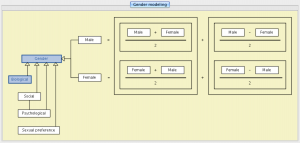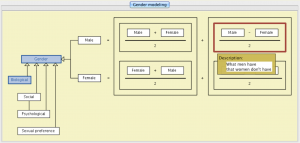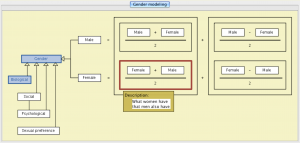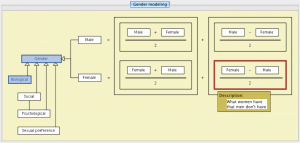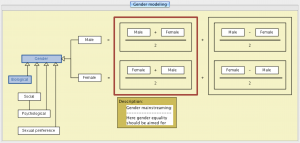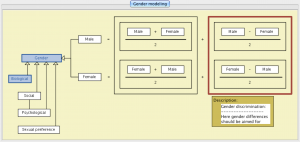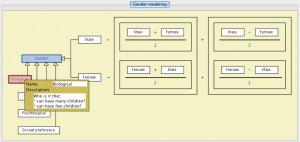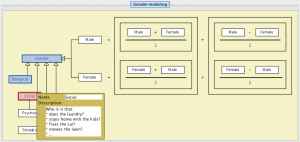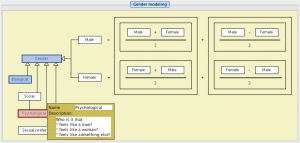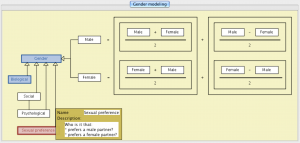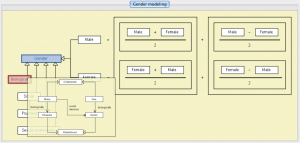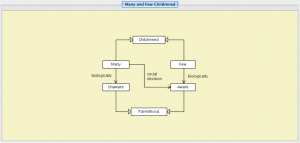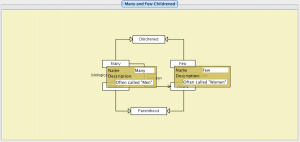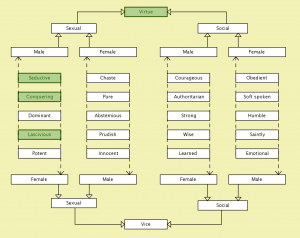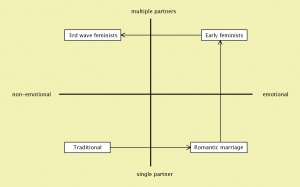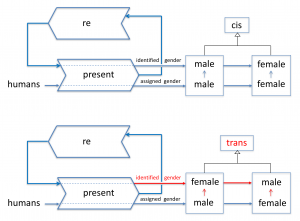This page is a sub-page of our page on Provocative Modeling.
///////
Related KMR-pages:
• …
///////
Books:
• Irrationality – A History of the Dark Side of Reason, Justin E. H. Smith, 2019.
• The Madness of Crowds – Gender, Race and Identity, Douglas Murray, Bloomsbury, 2019.
///////
Gender Modeling 2:
Gender Modeling 3:
Gender Modeling 4:
Gender Modeling 5:
Gender Modeling 6:
Gender Modeling 7:
Gender Modeling 8:
Gender Modeling 9:
Gender Modeling 10:
Gender Modeling 11:
Gender Modeling 12:
Gender Modeling 13:
Gender Modeling 14:
Gender Modeling 15:
////////
Male and Female Virtues and Vices in the early 19th century
Manliga och kvinnliga dygder och laster i början av 1800-talet
The development of female sexuality
///////
/////// Quoting Smith (2019, p. 216):
More Gender Trouble
Nowhere is this pollution more evident than in recent online conversation around gender. Here, many of the claims that are circulating might be most appropriately compared not with creation science, as discussed in chapter 5, but with flat-earth theory, in view of their extreme departure not only from prevailing causal theories of how the world got to be the way it is, but also from the most basic and immediately evident facts of human existence.
As of August 2018, Judith Butler, who has for decades stood atop the hierarchy of academic feminist theory, finds herself on the unpopular side of a sexual-harassment scandal involving one of her peers, and it may be that the process of her displacement, and of the succession of a new generation of theorists, has begun. However, up until just one month ago or so, as I write this, her word could still be cited in some circles as absolute authority, and few were made uneasy by this sort of argumentum ad auctoritatem. Consider, for example, this, from a recent online “syllabus”:
“[Judith] Butler proves that the distinction between sex and gender does not hold. A sexed body cannot signal itself as different sexually without cultural gender categories, and the idea that sex comes before cultural factors (which are believed to be only on top of sex), is disproven in this book. Gender is performance, there’s no solid universal gender basis beneath these always creative performances. There is no concrete sexed body without constructed human categories to interpret it.” [25]
But what happens when we move, as empirical science is prepared to do, from the question of human sex to the question of sex in the broader world of animals and plants? We know, for example, that the male of some species of anglerfish (e.g., Haplophryne mollis) is several times smaller and vastly weaker than its female counterpart. In order to mate, the only option it has is to bite into her bloodstream, and then slowly to wither away, eventually becoming a tiny appendage of its polyandrous spouce. Now, is there anything constructed about this? Anglerfish sexual dimorphism is extreme, but it is not different in principle from that of mammals. And if we insist that anglerfish reproduction is just a natural fact, while human sex and sex difference are constructed, then we are more or less explicitly claiming that human beings are not animals alongside others, but that their essence is nonnatural in origin. This is a fundamentally conservative stance to take, and Butlerites share it with traditional Christian theology, among other currents of thought. Butlerism buys its sex constructionism by means of a deepened commitment to species exceptionalism – and at a terrible exchange rate.
/////// End of quote from Smith (2019)
/////// Quoting Smith (2019, p. 220):
By dividing the world into “cis” and “trans” – allowing all sorts of gradations within the latter based on self-reporting alone, while seeing the former as an essential property of the people it supposedly describes – this new way of thinking has traded one binarism for another. “Cis-” is a prefix we previously know from geography: for example, Cisjordania, also known as the West Bank, was an area on “this side” of the Jordan River. But in recent years it has come to refer primarily to people who are on “this side” of the gender identity into which they were born, rather than having crossed over, as when one fords a river, into what appears to be another sovereign land.
To call a person “cis” is to hold that that person just is what she or he is, unambiguously, settledly. But if we are hoping to establish a way of looking at human variety that favors continuity and fluidity, how does it help matters to simply shift the fundamental rift from that between “male” and “female” to that between “cis” and “trans”? There is an irresolvable tension between the insistence, on the one hand, upon the illegitimacy of binary thinking, and, on the other, the equally strong insistence that an individual’s identity as, say, a cis man, is plainly and simply a matter of straightforward fact.
In March 2018 a blog post on the website of the American Philosophical Association audaciously complained that attendees at a recent APA conference had failed in large numbers to wear stickers stating their “preferred pronouns,” even though these had been made available to them [26]. It was noted that most of the people who declined were “cis” males, while in the same post it was also insisted that one cannot tell simply from looking at a person what their gender identity is. But this is a blatant contradiction. If you cannot know a person’s gender identity by looking at them, then how can you, from a visual scan of a conference room, tell the gender of the people that are being uncooperative with the effort to announce preferred pronouns?
A contradiction this glaring seems nothing short of intentional: as in religious mystery cults (about which, see chapter 1), the willingness to embrace the contradiction can function as a shibboleth of insider status; and the willingness to question it marks one off, sharply, as an outsider and an enemy. It is this sort of radical goats-and-sheep bifurcation that the algorithms of social media – which have now made the leap and come to determine the tone and tenor of such fora as the blog of the American Philosophical Association – have stoked and amplified over the past years.
It is not the question of transgender identity that interests me in particular here. This is only a particularly vivid example of a general feature of the current environment, which disinvites us from thinking about what it is like to be another sort of human being. This is particularly regrettable in the case of transgender identity, since on at least one plausible interpretation, which reaches back to the original semantics of the prefix “trans-,” to be transgender is precisely to have a transcendent experience of gender, to be able to know the experience of a different kind of people from the ones you were initially expected to spend your life identifying with. It is just this sort of transcendent experience that some radical feminists deny, and one might find it a missed opportunity that contemporary progressive thought has failed to fully embrace the account of what is happening when one changes one’s social identity from “man” to “woman”, or vice versa, as a variety of transcendence.
When Walt Whitman engages in a course of introspection, he discovers not only that he is a woman, a saurian, a plant, but that he also contains within him the entire geological history of the earth. “I find I incorporate gneiss, coal, long-threaded moss,” writes the poet [27]. The illiberal, discussion-closing accusation of transphobia is often accompanied by a claim that anyone who views matters differently from the enforcers of the new orthodoxy is in no position to speak, because such dissenters have not mastered and cited “the relevant literature” of the “experts” in the scholarly study of transgender identity and experience. But one might with far more justice insist that they themselves are in no position to speak, as they do not seem for their part to have read Ovid, Saxo, or Whitman, say, well enough to have absorbed certain crucial lessons. Nor have they studied the oral folk traditions of the world that offer rich insight into the continuity human beings experience between the identity assigned to them at birth and the many other sorts of entity with which, in a narrow empirical sense, they are nonidentical.
/////// End of quote from Smith (2019)
Humans representing as cis or trans:
///////
